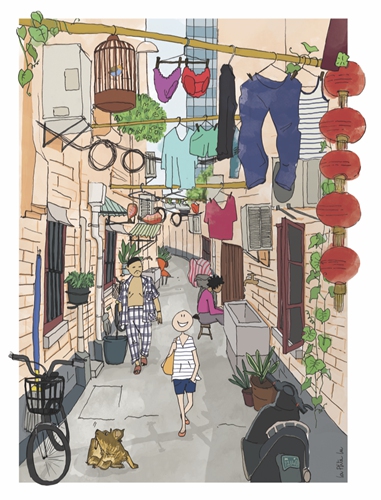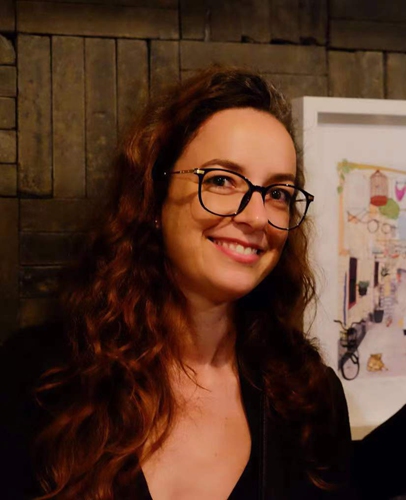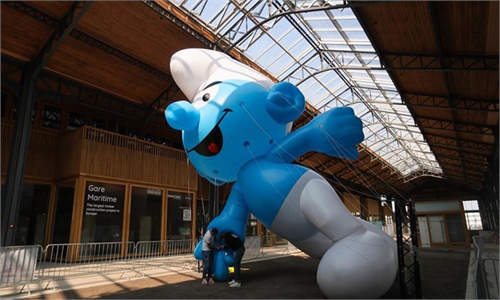ARTS / ART
French graphic designer turns her happy life in Shanghai into popular webcomic series
Second home

A comic by Guyard Lucie Photo: Courtesy of Guyard Lucie

Guyard Lucie Photo: Courtesy of Guyard Lucie
The origin of traditional Chinese festivals, dancing in public with Chinese dama (middle-aged Chinese women), cultural differences between the East and West… 37-year-old French woman Guyard Lucie who is preferred to be called Lucie, a graphic designer and illustrator, has been sharing her life in Shanghai over the past decade in a comic on WeChat that has attracted more than 22,000 followers from China and abroad.Born in Martinique, France, Lucie studied graphic design and then worked at a number of companies in Paris on web and graphic design. In 2010, Lucie went to Shanghai by chance and started her wonderful journey there. At the time, she never imagined that this city would become a home where she settled down, got married and had a cute little kid.
Since she was a child, Lucie has enjoyed painting and telling stories. It was this enthusiasm that led to the birth of the character "LaPtiteLu," the main character of the same-named comic strip she publishes on her blog and WeChat account.
"LaPtiteLu means 'The Little Lu' in French, which comes from my first name Lucie. At first the comic strips were a hobby, and then they became part of my job since I publish them on my official WeChat account," she explained to the Global Times.
With a passion for Chinese culture and a love for life and drawing, Lucie has penned many life-scenes about Shanghai and the collision of Chinese and French culture in the comic, which she has published on her WeChat account LaPtiteLu in Chinese, French and English since 2014. She now has over 20,000 followers, most of whom are Chinese or foreigners living in China.
Additionally, she also shares her comics on Instagram and her blog for viewers overseas, which has gained her a lot of attention.
Commenting on her work, a lot of readers share their opinions and offer tips to Lucie.
"It's interesting to see how different people react," she said.
In love with Chinese culture
When each traditional Chinese festival approaches, Lucie publishes a comic about the legends surrounding the festival for her readers. This could be the story of patriotic poet Quyuan for the Dragon Boat Festival, the beast nian for the origin of Chinese New Year or the folk tale of Cowherd and the Weaver Girl for Chinese Valentine's Day.
"I think a lot of foreigners, and maybe some Chinese, don't know exactly what is behind the festivals. So sometimes, it's good to go back to the basic of why we are celebrating that. I like to do some research and to understand the tradition, to discover the legend," she said.
Before sitting down to draw a comic, Lucie tries to read from various websites to get different points of view. Once she gets an idea of the big picture, she makes her own version by telling the story in her own words.
"For me, it is very enlightening because I learn something, and at the same time, I can share this knowledge and express it in my own way. I really like Chinese culture," said Lucie.
"The French festivals we have are different. It's never so poetic like in Chinese culture. It's about war and revolution, it's bloody, and it's a French way. I think the Chinese festival is always something very good through thousands [of] years of old legend," she added.
Different experiences
Besides traditional culture, Lucie also takes any little thing in her life as an inspiration for the comic. This could be the change of seasons, buying fresh hairy crabs at the market in each October and the experience of dancing in public squares with Chinese dama.
"I always see these ladies. They always put some cool music on very loudly. I feel it makes me want to dance. One day, I thought running was too boring, so I just stopped and joined them, and it was fun. It was very tiring actually. You need a lot of practice. It was something I wanted to do for a long time," Lucie recalled.
Lucie lives in a shared lane house in an old Shanghai alley. When she goes to her apartment, she has to go through her neighbor's kitchen.
"I always see them cooking and their meals, but I like that. You will never have such a scene in France. It's cool."
The difference between China and France is also shown in her works about how people in the two countries handled COVID-19.
"In the fight against this pandemic, we have a total opposite behavior. Chinese are incredibly obedient, they follow the rules carefully and still have a real fear of the virus even today, while French people seem to act as if they are invincible, many of them behaving as if they aren't afraid of anything and don't care about others…" Lucie drew the difference in her comic.
Living in Shanghai for one decade, the biggest change in Lucie's eyes is the quick changes in Chinese technology. She now has grown used to using WeChat to pay for rent and to talk to local people via WeChat translation.
"When I go to France, all little things like this are so annoying and difficult, because there is no such convenience in France," she said.
Although she still hasn't decided how long she will stay in China, the county has become her second home, with her family, her work and her drawings.
"I like to absorb Chinese culture. I like to live like a local to indulge in the small lanes. It's part of me now."





